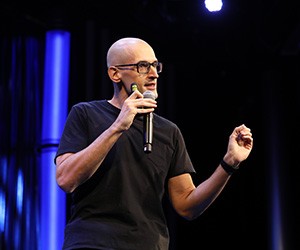Shrinking budgets and long hours lead the list of event planning challenges/worries, according to a new survey conducted by Event Manager Blog Editor Julius Solaris and released during his "Event Trends for 2019” educational session at IMEX America in Las Vegas. During the presentation Solaris also highlighted a number of event planning trends to watch for in the year ahead and some practical advice for meeting planners.
According to the study, the percentage of respondents listing various issues as concerning for 2019 are as follows:
- Shrinking budgets: 55.5%
- Long hours: 30.2%
- Unethical behavior: 29.2%
- Lack of career progression: 28.1%
- Terrorism: 24.7%
- Health and security: 17.7%
- GDPR: 16.3%
- Legal action: 14%
- Fraud: 13.4%
- None of the above: 12%
- Medtech legislation: 8.2%
The Solaris-led study also asked event planners to estimate how they expect their overall budgets to change in the 12 months after the survey, with 64.4 percent responding they thought their budgets would stay the same; 26.1 percent expecting their budgets to increase; and 9.5 percent predicting a decrease in budgets.
[Related Content: Event MB's Julius Solaris Serves Inspiration at IMEX]
“Shrinking budgets are an issue for sure for 2018 and we can only expect it to be a major issue in 2019,” Solaris said during his IMEX education session. “But budgets are the same if not higher. Why do we feel shrinking budgets are a concern if we have the same budget or more? Costs are going up, absolutely. And they’re taking money from meetings for other areas, absolutely. And it’s a question of expectations. We’ve seen it all.
"How are we going to surprise them again this year?" he asked the audience.
"We need to be able to deliver effectively with efficiency," Solaris concluded.
Important Event Planning Trends to Monitor and Address in 2019
Solaris then launched into a rapid-fire list of event planning trends he sees shaping the meetings and events industry in 2019, including the following emerging issues planners should consider.
Kiosks at Events: “If the airline industry is doing something, keep an eye on it. With airline check-ins, now you have two staff members and a lot of kiosks. It’s time to invest. If you’re thinking about it, do it. It works.”
Electronic Banners and Signage: “Just use digital. Don’t overthink this. Just do it. If you’re trying to be flexible and save money, use digital signage, definitely.”
Drop the Event App: “In some instances we’re over-teching things. In some instances it’s not needed, in some it’s very needed. If you’re talking 20 people that are there to do business, don’t [use an app]. You can have separate tools that are not a mobile app. But if you have a larger show, do the app—that’s the best way to save money. We need to support mobile and use it functionally at the event.
"Make sure the app has a role in the event. Make sure you have a plan for the app.”
Don’t Pay for Unnecessary Travel for Attendees: “I do believe in the power that tech has to connect people. Sometimes we push it too much to make people travel when they can be in their office.
"If Google has done it, we can do it. [Google] connected their leadership team to their meetings via VR technology. Google saved a lot of money on unnecessary travel there.”
Speaker Management: “I believe we can save money today on speakers. There are opportunities to do better with content. There’s too much going on. If I go to the event I want the strategic content to allow me to improve. Get the most relevant content out there and I can go back to share back in my office with my team, etc.
"Use the 10/40/50 formula: 10 percent keynote, 40 percent travel and accommodations (or minimal fee); 50 percent sponsored.
[Meetings Today Podcast: Cutting-Edge Meetings Trends From Event Manager Blog's Julius Solaris]
Solaris added that events can spend more money on speakers when there is more promotional material, such as sponsored content, that can be leveraged.
“Work with them to make sure their session is very relevant and focused, with a very specific brief—a very controlled effort on sponsored content. Content is critical and the most important thing to your attendees,” he advised. “Tell them the number of slides. Give them a template—‘don’t go outside of the template!’ I respect my audience, so it needs to be thought leadership. They have an analysis that independent speakers don’t have, they have data that keynote speakers don’t have, so work with them. But don’t control your keynote.
"If you have to control your keynote, you don’t have a good keynote. The potential for disruption is there. These people can turn into promotional machines.”
Cut Down on the Lines: “Do you like lines? There’s a lot of people coming to my event—is that a good thing? Facial recognition is the [tool]. I thought 2018 would be the year of facial recognition but it wasn’t. I think 2019 will be the year. It’s five times faster. Orlando Airport is 15 percent faster due to facial recognition.
"It’s great for large shows but also for small shows. We’re talking about the experience, so why are we accepting the line as part of the experience? We can improve on that. The cost is minimal.”
Cashless Payments: “Work with suppliers and those who sell at your shows. [Going] cashless increases revenue by 15 percent. Definitely keep an eye on this.”
FOMO: “Fear of Missing Out. It’s beyond social media. Start to introduce different levels of experience for tickets—economy, general, standard, business, VIP and premium levels; photo ops with speakers such as Tony Robbins. Usually a conference [features] early-bird pricing. The slow-ticket model is what’s happening now. Taylor Swift said, ‘If you buy my album you’re going to get priority tickets to my concert.’ It killed scalpers.
"Get it, understand it, because this is changing things now.”
JOMO: “This is the year of JOMO: The Joy of Missing Out. Sometimes we enjoy missing out. We’re now getting to this stage, sadly, within events as well. Do you feel the fatigue on day two? Really, another day? C’mon!
"We need to give the option to disconnect because it’s too much information. Putting more sessions on the schedule is going to attract more people, but once they’re there, give them a break—lounges, innovative sponsorships. JOMO also means doing my job. I can’t forget my job for three days.
"Give me a break where I can do that. You can provide these spaces at conferences.”
High-Involvement Sponsorships: “We’re talking about meaningful sponsorships,” Solaris said, then referenced the organ donation promotion drive by Brazilian soccer team FC Recife he mentioned in his Smart Monday keynote at IMEX America. “Apply the same concept on a smaller scale.”
Safety First: “Cyber security data breaches—it’s happening all around us. The partners that you work with should be in charge of your brand safety. Technology is part of the experience. It’s a delicate compromise. If we are too safe it’s going to impact the experience—long lines, a registration process that never ends, triple log-in on your mobile app. We want attendees to enjoy the event without noticing—they feel safe.
"There’s nothing to see. Everything is working. We should accept vendors that take this seriously. It takes one person that’s not happy about how you handle data and you’re in trouble.”
The Rise of the Uncomfortable: “Use the craze for escape room strategy games within your event. Embrace the dark side for the ultimate thrill factor. It’s a creative element that makes your attendees feel they’re not experiencing the same things all over again. Use extreme adrenaline to simulate a time-sensitive work scenario to enhance problem-based learning, and use virtual reality activations for game play to push the boundaries—from making them feel spoiled to almost making them feel unspoiled.”
Smart Badges: “The badge at IMEX doesn’t cut it. It’s non-action data, but whenever you’re asking your attendees to pull out their phone and do stuff it’s a waste of time. In an event environment two minutes is an eternity. Voice is the next step. It’s an enabler that makes it easier for all people. We don’t have the time to go other places to get information. No action is needed. This is 2019. We can do better than business cards.
"The beacon will recognize you and also provide easy feedback and can track the number of people that come to a booth.”
Cause Marketing: “The opportunity for greater good. It’s not direct revenue, but it helps a lot in the perception of your conference. Work with your local community.”
Content Leads: “The content is becoming part of the package. When content is part of the process it establishes your event as a valuable source of information. Use reports. Use your speakers. Use your performers. Use them strategically. It can be videos and strategic content from previous years.”
Seating Matters: “We’re strategists today. When there are some parts of the audience that are there on the panel, add funky tables. Have a standing panel. For modesty have a cloth table. Use flowers.
"Try to ‘protect’ your speakers [by sitting or standing them behind something]. This is about respecting the people that are there to perform at your event.”
Stop Harassment: “It’s happening all around the industry, especially at tech events. If there are bad people in your audience that use alcohol, then that’s going to be a big enabler for them.
"[Follow] Project Event Safe by Rand Fishkin, who’s creating a database of people who attend conferences and harass people. Things are changing in the industry.
“And finally, we’re seeing women saying, ‘Why are we seeing Julius Solaris doing this keynote in an industry that is 80 percent female?’” Solaris said at the end of the session, emphasizing that there are too many male speakers in an industry that’s predominantly female.
[Read This Next: How to Create More Welcoming Events (IMEX America Education Session)]







